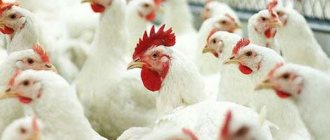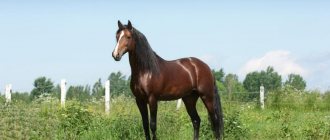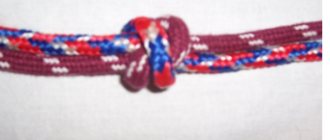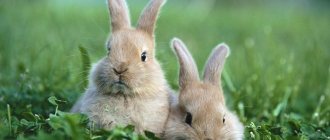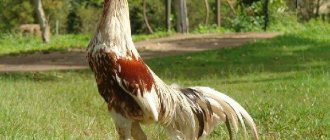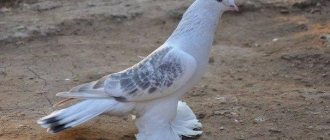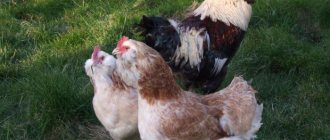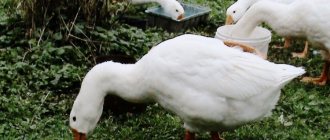Arabian horses are the most beautiful horses in the world
Arabian horses are unique horses that have always amazed and will never cease to amaze with their exquisite beauty and bewitching features. A characteristic feature of Arabian horses is a tail raised high, a pike-shaped head structure with a convexity, almond-shaped eyes and bottomless dark eyes filled with infinite kindness. The muscular structure of the body makes the horse as graceful as possible. Thanks to such grace, Arabian beauties move smoothly and as gracefully as possible. In Arab countries, such horses are considered a priceless gift from Allah. Today, Arabian horses have retained the purity of the breed, because their reproduction occurs in isolation, so that there is no mixing of other breeds.
Mustang
Translated from Spanish, this word means “wild, no one’s.” The most famous breed of American horses, although they were not originally native to America. The ancestors of these horses were brought by the French and Spaniards from Europe in the 17th century.
Until the 20th century, their population numbered about 2 million in all states. Now horses are on the verge of extinction, and the reason for this is the hunting of wild horses, which was carried out in the 20th century for their meat and skins. Also, due to their good endurance, they began to be actively used in the household. Today, the protection of this breed is controlled at the state level and they can only be found in nature reserves and natural parks.
Externally, mustangs are small in stature, height from the ground to the top of the head is 150 centimeters, weight - 400 kilograms. The build is average, the legs are strong and powerful. The colors are mainly piebald, red and bay, but black mustangs can also be found. Mustangs live in herds and, like any herd, they have a main male and female.
Akhal-Teke
The Akhal-Teke is the pride of Turkmen horse breeders; since ancient times it has been considered one of the most beautiful horse breeds. The amazing harmony of the body structure makes the Akhal-Teke an amazing horse. The extraordinary color can be compared to the beauty of desert sands burning under the golden sun. These horses glow with extraordinary beauty not only from the outside, but also from the inside. Nature has rewarded this breed with extraordinary temperament, pride and grace. Of course, distrust and wariness towards people can be called a shortcoming of the breed, but the horse will be devoted to its owner all his life. The external cuteness of the Akhal-Teke makes one think that the owners of this beautiful horse are grooming and cherishing the horse.
Feeding
The health of horses largely depends on proper feeding. Many owners also want to know how much it will cost to feed the animal. The daily or daily ration of a horse, whose weight is about half a ton, consists of the following products:
- hay (the best option is clover with legumes or meadow) - 10-13 kg;
- oats, muesli, ready-made grain mixtures - 5 kg;
- bran from oats or wheat - 1-1.5 kg;
- carrots - 2-3 kg.
Along with carrots, the animal can eat other vegetables. Be sure to include regular salt and vitamin supplements in your diet. A horse's annual diet consists of:
- 4-5 tons of selected hay;
- 2 tons of grain mixture or oats;
- 0.5 tons of carrots and other vegetables;
- 13 kg salt.
In summer, the horse can graze on pasture; the amount of hay is reduced, but not completely removed. You cannot immediately put a horse on green feed; this should be done gradually. Before allowing horses to fast, they should be well fed with hay. It is necessary to ensure that the food is fresh, without signs of rotting or mold, and that there are no poisonous plants in the hay. Thoroughbred horses are quite picky in their diet, with their own tastes.
The animals are given water several times a day. A horse drinks 60-80 liters per day; a bucket or small barrel is suitable for watering. You should not give your horse too much to drink immediately after exercise, as this can negatively affect digestion. Horses are given water before meals so that the food is better absorbed. Domestic horses can drink from open sources only if there is complete confidence in the quality of the water. Since it is difficult to find such reservoirs, it is better to train your horse to drink only at home.
The most beautiful horses in the world: photos of lush-maned friezes
Lush-maned friezes are unique horses that make you admire their endowed beauty ad infinitum. This breed leaves no one indifferent, since the nobility and pride of a horse has no boundaries. The individual feature of the bushy-maned frieze is revealed already in the very name of the breed. Their long and wavy mane looks exactly like a fluffy ponytail. This breed is found only in black, but once upon a time there were also bay, bushy-maned horses. The slender physique, long neck and smooth lines are emphasized by brushes on the hooves. Regarding the character of the breed, we can say the following: poise, nobility. The regal gait easily gives way to graceful energy.
Menoran horse
The Menoran horse is characterized by a strong character, endurance, and courage. The animal is easy to train. They are often used to participate in square dances, which require a synchronized performance - horses rise on their hind legs, spin around, and demonstrate their skills.
The birthplace of Menorca is considered to be the island of Menorca, located in the Mediterranean Sea. Not so long ago this breed became popular. Externally, the Menoran horse is similar to the Spanish Andalusian horse, but some features distinguish it. Horse height varies between 154-160 centimeters for mares and 162-165 centimeters for males.
The horse is considered lanky. The animal has long and dry legs, a lush elongated tail and mane, a small head with neat ears. Menoran horses are exclusively black in color. An annual festival is held on the island when horses are dressed up in traditional costumes - the animals delight residents with beautiful performances.
The Oryol Trotter is the most beautiful breed of horse
The magnificence of the Oryol trotter has been confirmed over the years. This breed is rightfully considered the pride of Russian horse breeding. The Oryol trotter is famous for its mesmerizing beauty. Already in the genes of a horse is a frisky trot. The patterned color is a unique characteristic feature of the Oryol trotter, but the most common colors are also found among representatives of this breed. The long neck can easily be compared in beauty to a swan, and the expressive eyes can be used to judge the kindness and intelligence of the horse. Despite their amazing agility, speed and energy, Oryol trotters have a calm disposition. This contrast makes the horses unique.
Visual abilities
The structural features of the eyes determine what vision capabilities nature has endowed horses with.
Visual field
The location of a horse's eyes on the sides of its head gives the animal a much greater field of vision than a human. When the head is raised, the field of vision approaches spherical.
This feature is present in many animals that can at any moment become a victim of a predator, but in horses the eye sockets are turned slightly forward, which gives a viewing angle of approximately 60°.
The “blind spot” of horses is insignificant - they only do not see what is happening immediately behind the back of the head, above the forehead and under the chin. And to see these places, even a slight turn of the head is enough.
Learn how to apply nutrition to your horse's hooves, joints and coat.
Visual acuity and focusing
The animal's visual acuity is slightly higher than that of humans. Modern scientists believe that the retina, right in the center of the eye, is crossed by a small horizontal line that is filled with receptor cells - this is the area that perceives light best.
Its action is similar to the function of the fovea in the human eye. The fact that it is deployed horizontally makes it easier to view objects on the surface of the ground - this helps the horse detect predators and possible obstacles.
Are the colors different?
Well-known expert and long-time equine vision specialist Dr. Brian Timnay believes that horses are similar to humans with a slight impairment in color perception.
He is confident that these animals have no problem distinguishing red or blue from gray. Regarding green and yellow, the results are contradictory.
Did you know? During races, horses are less likely to knock down an obstacle when jumping over it if it is painted not one color, but two or more.
However, it can still be said with certainty that horses distinguish colors and easily react to them. For example, if you take two feeders, red and blue, of the same shape, and regularly put food only in the blue one, the horse will begin to recognize it and only approach it, ignoring the red one.
Can they see in the dark?
In the dark, a horse can see better than a human. There are almost 20 times more rod cells on the retina of a horse eye, which perceive weak light well, than cone cells.
In addition, under the retina of this animal there is a kind of “mirror” made of silvery crystals (tapetum). The light reflected from it moves back through the retina, making it less likely to miss the rod receptors.
Find out what is notable about the horse breeds: Soviet draft horse, Trakehner, Friesian, Andalusian, Karachay, Falabella, Bashkir, Oryol trotter, Appaloosa, Tinker, Altai.
Even if this causes some scattering of the clarity of the outlines, it does not prevent the animals from orienting themselves well in the dark.
Owners should be aware that horses do not adapt well to sudden changes in light, so they may be frightened by, say, moving from a lawn to a dark van.
The complex structure makes the horse's visual organs very sensitive to external influences, so they are often exposed to a variety of pathological processes.
Englishwoman
The beautiful appearance of the Englishwoman makes the breed one of the most beautiful on the planet. The simplicity of the monochrome color and individual appearance fascinates with beauty. The horse's sculpted physique gives it a noble appearance. Despite the simplicity of color, this breed is generously endowed with amazing grace and mysteriousness. The short-haired coat of the Englishwoman is so smooth that it shimmers like the reflections of water in the sun. The breed is ideal for riding, and therefore you can often see an Englishwoman at equestrian competitions.
Maintenance and care
You should learn everything about horses before owning these animals or simply engaging in horse riding. Animals are kept in stables that have:
- Stall. The room where the horse stays temporarily, eats, is inspected and cleaned. There are no partitions in the stall; it is a closed pen with a bar for tying horses and a manger for food.
- Dennik. A house or place where the horse lives permanently. Its area is 3.6x3.6 cm, so that even a lying mare can fit in it. A separate stall is made for each domestic horse, partitioned off with incomplete lattice partitions. Instead of a lattice, there may be weaving. The doors are designed in such a way that the horse cannot open them on his own, and are no more than 1.1 m high. The exit from the stall can be made into a common gallery or directly onto the street.
- Territory or levada for walking. A site with an area of 100-200 m².
The height of the stable is made no less than 2.6 m. The floor is best made of concrete with a rubber coating. The bedding is made from straw. The stalls are equipped with gutters for draining liquid waste, which means that manure needs to be removed less often. The stalls are cleaned daily and the litter is completely changed once a week.
Direct horse care with your own hands includes:
- cleaning the body;
- combing the mane and tail, it can be braided;
- hoof cleaning;
- bathing;
- forging;
- special attention is paid to the horse's teeth.
For cleaning, use a natural brush with stiff bristles; it is advisable that the horse is tangled. Start from the head on the left side, move to the sides, back and croup. Repeat the procedure on the right side, scratch the mane and tail, you can also braid them (horse hair can be very interesting). At the end, the hooves and legs are trimmed. To clean the hoof, special brushes, sticks and hooks, and lubricating cream are used. Only a professional can forge a horse; you should not do this yourself. A shoed horse is less likely to injure its hooves.
Shire
The Shire is one of the largest horse breeds on Earth. Their massiveness is their own advantage. The friezes on the legs and the lush mane make the horse quite beautiful. In any large-scale cultural event, they try to use this particular breed as decoration. The horse itself is very hardy. The height at the withers can reach one hundred and seventy-five centimeters, which makes the Shire a unique horse. But not only endurance is an advantage of this horse, but also obedience. The obedient nature serves as a reason for crossing with other breeds of horses in order to pass on this trait.
Impact on humans
The horse helps get rid of fatigue and depression. Problems with the musculoskeletal system are also treated with the help of hippotherapy - working with horses. The fact is that the human body repeats every step of the horse on which he rides! And those who constantly work with horses are much less likely to catch colds: the lungs and bronchi are sanitized with the help of the vapors of manure and the sweat of horses. Diabetes mellitus is also practically not found among horse workers. In the USA, small horses work as guides for the blind; they can even read road signs.
Scientists, by the way, have long proven that animals help people with health issues. And horses are no exception!
Donskaya Beauty - the most beautiful Cossack horse
The charming beauty is made to be endlessly touched by the beautiful breed of horse called the Don Beauty. The temperament of a red-haired beauty can be judged by her color, because it’s not for nothing that they say that redheads have a special character. The Don beauty is not only hardy, but also very persistent. The speed of movement never slows down, even if there is a difficult obstacle on the way. The Don Horse is very emotional and is able to understand a person’s mood.
As you can see, we can talk endlessly about the beauty and kindness of unique breeds. All the most beautiful horse breeds are endowed not only with grace and elegance, but also with an open soul, which cannot always be said even about a person. Looking into the expressive eyes of playful handsome men, you can see endless kindness, responsiveness and understanding of everything that happens. Beauty and intelligence merged into one. The painstaking work of horse breeders contributes to the emergence of new types of horses with unique external characteristics and individual abilities. And they are all beautiful.
Painthorse
This breed of horse is quite popular. Paint Horses have a very beautiful appearance. They have very expressive blue eyes, and their color is two-tone. The base color is always darker, but the spots are a lighter shade. The most common color is white and red or white and black.
Peithorses are about 165 cm tall, and the weight of adults reaches 500 kg. The body is muscular and strong. The croup is rounded, the head is medium-sized, the neck is long with a beautiful bend. Horses of this breed are very friendly and you can easily establish contact with them.
All of the above-mentioned unusual horse breeds have their own characteristics that are unique to a specific species. And each horse is good in its own way. This list can be continued endlessly, because there are more than 200 horse breeds in the world, and only 10 of them are mentioned in this article.
Falabella
The Falabella is the world's smallest horse breed.
- Height: 40 – 75 cm.
- Weight: 20-60 kg.
The body structure of this horse is proportional and graceful. The head is a little large. They can be any color: bay, piebald, forelock, roan.
The breed was developed in Argentina and was named after the family that bred these miniature horses. To maintain size, the smallest stallions were included in the breeding program. Falabella is popular in many countries. Bred mainly in the USA.
Important! Falabella should not be confused with a pony. Despite their miniature size, horses of this breed are distinguished by the proportionality of their tall riding relatives: they have long, thin legs. The pony has a massive build and short legs.
This mini-horse is very playful, light, loves to jump and frolic. He has a good disposition and is easy to train.
This is not a working animal, but an ornamental animal. Falabella horses are often kept as pets. They develop a strong connection with their owner. They are not intended for horse riding, but they can pull small children's sleighs - which is used in games.
Connemara pony
The Connemara Pony is the tallest of all pony breeds.
- Height: 128 -148 cm
There are different colors - gray, bay, black, dun, red, roan. The head is small, with a square muzzle, large kind eyes, a muscular strong body, short strong legs.
It was bred in Ireland and is the only national breed of horse. It is not known exactly where the Connemara ponies originated from. There are versions that they are descendants of Spanish horses brought to Ireland 2500 years ago. It is possible that the ancestors of these ponies came to the island after the sinking of a Spanish warship from the Invincible Armada in 1588. The society of breeders of this pony was formed in 1923. Today, the Connemara pony is popular not only in the UK, but also in other European countries, as well as in the USA.
These ponies are kind and balanced. Easily adapt to different conditions. They can hold a child or a light adult. Usually obedient, but sometimes unpredictably offended and stubborn.
They have long been involved in agriculture - they are hardy and unpretentious. Today Connemaras are used in sports.
